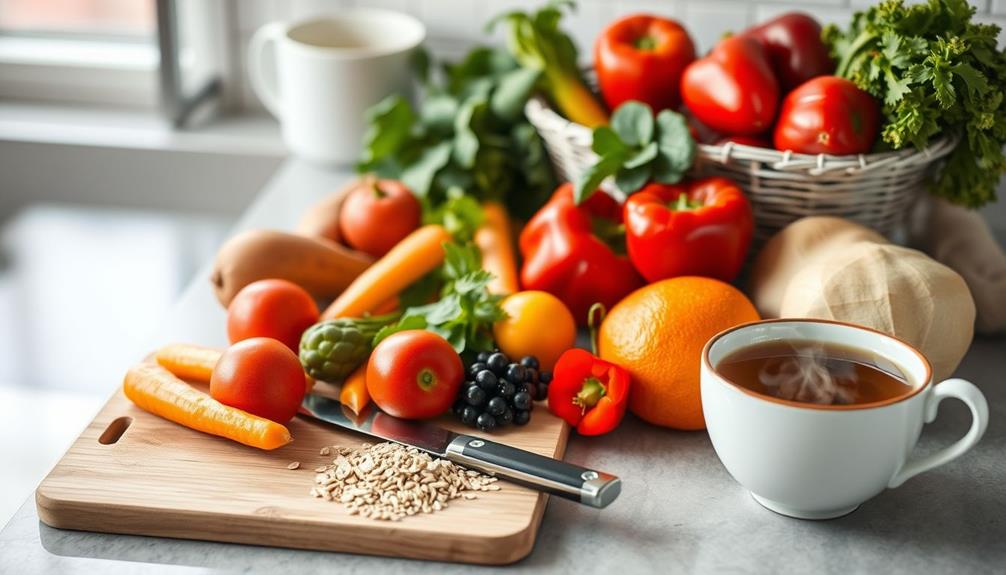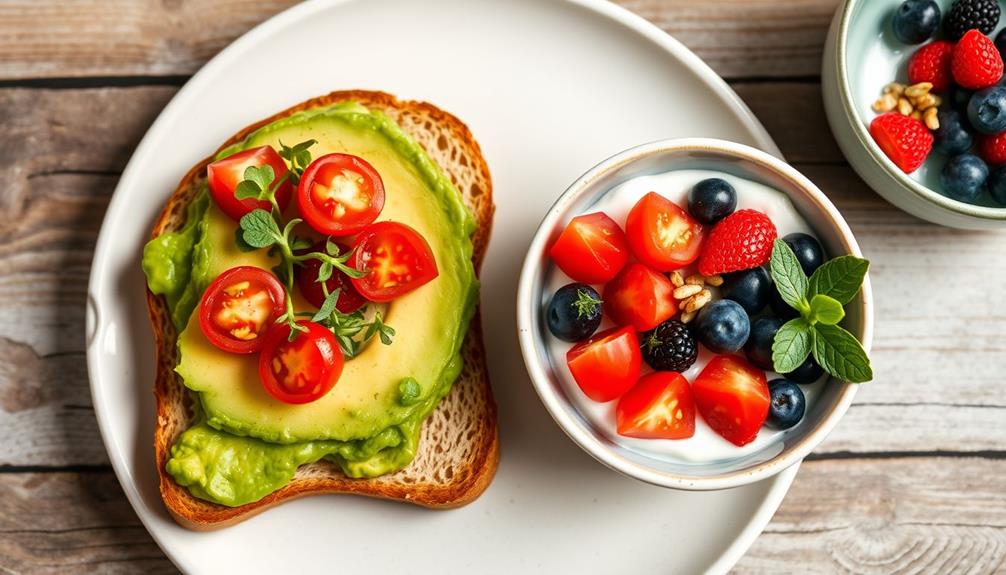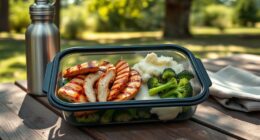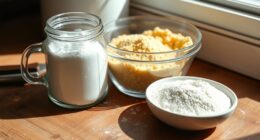To set up a keto diet, start by cutting your carb intake to 20-30 grams daily. Focus on high-fat foods like avocados, olive oil, and fatty fish while incorporating low-carb veggies such as spinach and broccoli. Eliminate sugary foods, grains, and starchy vegetables to maintain ketosis. Create a meal plan that aligns with a macronutrient ratio of about 70% fat, 20% protein, and only 10% carbs. Keep track of your food intake and ascertain you're hydrated, balancing electrolytes to stave off keto flu. There's a lot more to explore about adjusting to this lifestyle that can enhance your experience. In addition to adjusting your macronutrient ratio, it’s important to stay mindful of portion sizes and listen to your body’s hunger and fullness cues. Many people find that the keto diet benefits include improved mental clarity, sustained energy levels, and weight loss. It’s also important to consult with a healthcare professional before making significant dietary changes to ensure it’s a safe and appropriate choice for you. Remember, everyone’s body is different, so the keto diet may not be suitable for everyone.
Key Takeaways
- Determine your daily macronutrient targets: 70-80% fat, 15-20% protein, and minimal carbs (20-30 grams).
- Create a meal plan incorporating high-fat foods like avocados, fatty fish, and low-carb vegetables.
- Eliminate sugary foods, high-carb grains, starchy vegetables, and legumes to maintain ketosis.
- Stay hydrated and balance electrolytes by increasing sodium, potassium, and magnesium intake.
- Track your food intake and ketone levels regularly to ensure you're maintaining ketosis effectively.
Understanding the Keto Diet
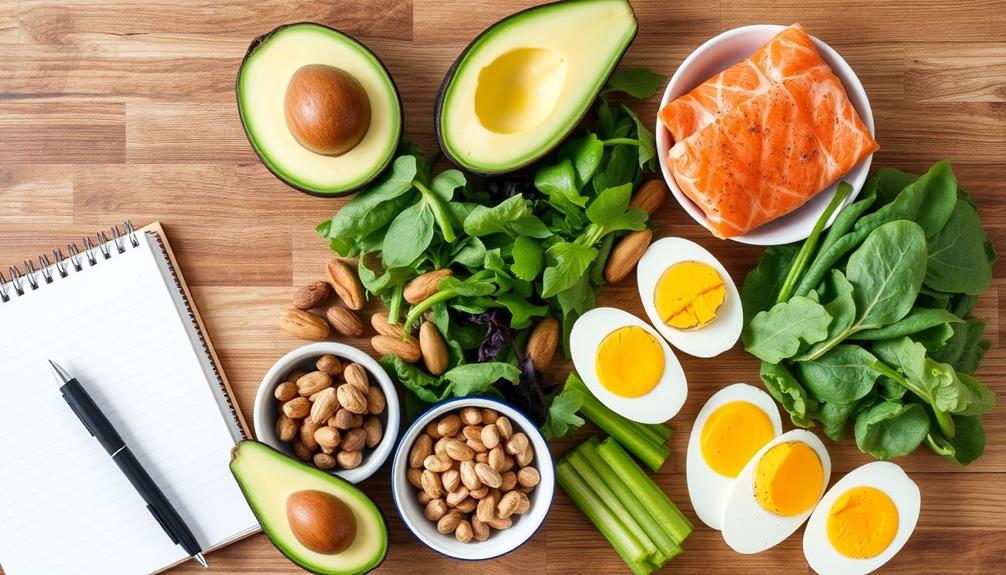
What makes the ketogenic diet so effective for many people? The keto diet helps your body enter a state of ketosis, where it burns fat for fuel instead of carbohydrates. By drastically reducing your carb intake to about 20-30 grams per day, you shift your metabolism to rely on healthy fats.
This high-fat diet typically consists of 70-80% fat, 15-20% protein, and minimal carbs, encouraging you to consume foods like avocados, nuts, and fatty fish while avoiding starchy vegetables and sugars. Additionally, a diet rich in healthy fats can provide essential nutrients, similar to the benefits seen in juice diets.
The ketogenic diet can profoundly impact your weight loss goals by promoting fat loss and enhancing energy levels. Initially developed to manage epilepsy, this low carb diet has gained traction for its benefits in blood sugar control, especially for those with type 2 diabetes.
However, changing to a keto diet may come with temporary side effects, often referred to as "keto flu," which can include fatigue and headaches as your body adapts.
To achieve success, you'll need to carefully manage your protein intake and focus on maintaining your fat consumption. With dedication, the ketogenic diet can lead to substantial weight loss and improved overall health.
Essential Foods to Include

To successfully commence on a ketogenic journey, it's important to stock your kitchen with the right foods. Start by including high-fat options like avocados, olive oil, and fatty fish such as salmon. These foods help guarantee your diet consists of 70% to 80% fat, promoting effective ketosis.
Additionally, incorporating common types of cold medications can be beneficial if you experience any cold symptoms while adjusting to your new diet.
Next, incorporate low-carb vegetables like spinach, kale, and broccoli. These provide essential nutrients while keeping your carbohydrate intake below 20-50 grams per day.
Quality protein sources are also vital; think grass-fed beef, chicken thighs, and eggs. Aim for protein to account for 10% to 20% of your daily caloric intake.
Don't forget about full-fat dairy products! Cheese and heavy cream contribute to your fat intake while minimizing carbohydrate content.
For snacking, consider nuts and seeds; just be mindful of portion sizes to avoid exceeding your daily carbohydrate limit, as even low-carb options can add up quickly.
Foods to Eliminate

To successfully maintain a keto diet, you need to eliminate sugary foods like soda, candy, and cakes that can spike your carbohydrate intake.
Additionally, focusing on effective strategies for weight loss can help reinforce your commitment to the diet.
It's also essential to avoid high-carb grains and starchy veggies, as they can disrupt your body's ability to enter and stay in ketosis.
Sugary Foods to Avoid
Eliminating sugary foods is essential for anyone starting the keto diet. These foods, like soda, fruit juices, cakes, and candies, can greatly increase your carbohydrate intake and hinder your ability to enter ketosis. Individuals with certain mental health challenges, such as Borderline Personality Disorder (BPD), may find it particularly important to maintain stable blood sugar levels, as emotional regulation can be influenced by diet.
Instead, focus on low-carb options that keep your carb count in check. You'll want to steer clear of most fruits, as they often have high sugar content. While small portions of berries can fit into your ketogenic eating plan, it's best to avoid other fruits altogether.
Additionally, grains such as wheat, rice, and pasta are packed with carbohydrates and can disrupt your progress toward burning fat for fuel. Don't forget to eliminate beans and legumes from your diet. These foods are rich in carbohydrates and can make it challenging to achieve the low-carb threshold necessary for ketosis.
High-Carb Grains and Starches
Avoiding high-carb grains and starches is essential for anyone serious about the keto diet. Foods like wheat, rice, and oats are packed with carbohydrates that can derail your efforts to achieve ketosis. To maintain a successful ketogenic lifestyle, you should eliminate these high-carb grains.
Understanding your budget for food expenses can also help you make smarter choices that align with your dietary goals.
Starchy vegetables such as potatoes, sweet potatoes, and corn also contain high amounts of carbohydrates, making them unsuitable for your daily limit of 20-50 grams of net carbs. Popular staples like bread, pasta, and cereals contribute to spikes in blood sugar levels and should be avoided.
Legumes, including beans and lentils, while nutritious, are too high in carbs for a keto diet, so it's best to minimize or completely eliminate them from your meals.
Even whole grains, often viewed as healthy, can contain significant amounts of carbohydrates. Always check nutrition labels to verify you're staying within the ketogenic carb threshold.
Meal Planning Strategies
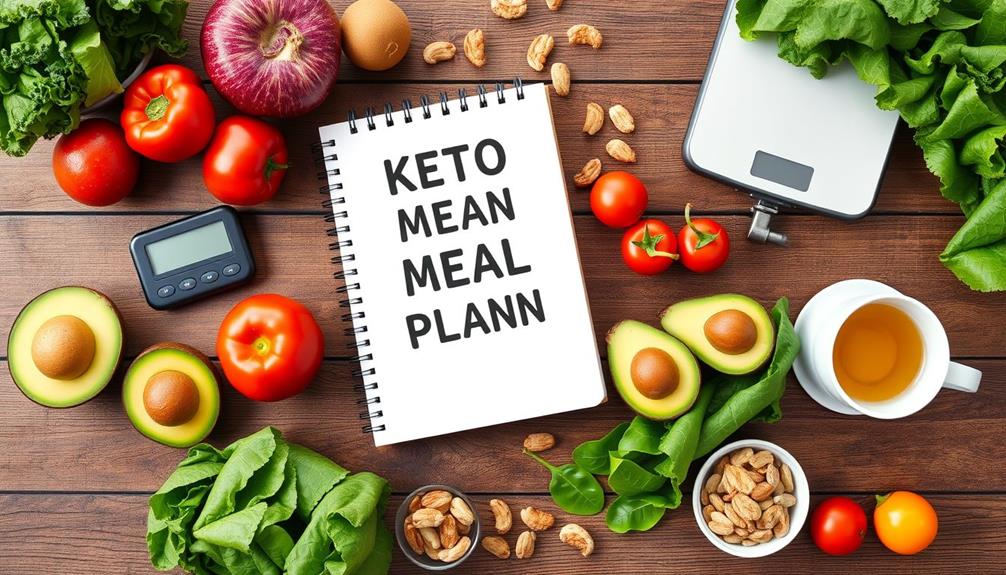
When it comes to successfully following a keto diet, effective meal planning strategies are crucial for staying on track and meeting your macronutrient goals. Start by determining your daily targets, aiming for about 70% fat, 20% protein, and 10% carbohydrates, while keeping net carbs between 20-50 grams. Understanding how different food types interact with your body can help you make informed choices, especially when considering the unique aspects of coffee culture that may complement your diet.
Next, create a weekly meal plan that incorporates high-fat foods like avocados, nuts, and fatty meats, along with low-carb vegetables such as spinach, broccoli, and zucchini to guarantee nutrient density.
Preparing meals in advance by batch cooking keto-friendly recipes can save you time and reduce temptation on busy days. Look for recipes online or in keto cookbooks to explore a variety of meal options that fit your dietary preferences.
Additionally, keeping keto snacks on hand—like cheese, hard-boiled eggs, and nut butter—will help manage hunger between meals. This guarantees you won't reach for high-carb alternatives when cravings strike.
Managing Electrolytes and Side Effects

When you start a ketogenic diet, balancing your electrolytes becomes vital to avoid common side effects like fatigue and headaches.
Essential oils, such as eucalyptus oil, can provide additional support for respiratory health during this shift.
Managing symptoms of "keto flu" requires you to stay hydrated and guarantee you're getting enough sodium, potassium, and magnesium.
Importance of Electrolyte Balance
Maintaining electrolyte balance is essential for anyone starting a keto diet. As your body enters ketosis, it excretes more water and electrolytes, which can lead to imbalances if you're not careful. This is where the significance of sodium, potassium, and magnesium comes in. Aim for 3,000 to 5,000 mg of sodium daily to help maintain hydration and blood pressure.
Foods rich in potassium, like avocados, leafy greens, and nuts, should also be part of your meals to support electrolyte balance. Additionally, just like how proper care is important for pet health, managing your electrolytes is critical for your well-being on the keto diet a balanced diet is key.
If you experience symptoms like dizziness, muscle cramps, fatigue, or headaches, you might be facing what's commonly referred to as "keto flu." To combat this, staying hydrated is important—try to drink 6-8 glasses of water daily.
Incorporating broth or electrolyte supplements can also help you manage these side effects during the initial adaptation phase. By being mindful of your electrolyte intake and focusing on the right foods and hydration, you'll set yourself up for a smoother keto experience and keep those pesky symptoms at bay.
Common Side Effects
Adjusting to a keto diet can bring on some common side effects, often referred to as "keto flu." This includes symptoms like fatigue, headaches, and nausea, which usually clear up within a few days to a week as your body adapts to burning fat for fuel.
During this shift to ketosis, it's important to pay attention to your electrolyte balance, as increased water and electrolyte loss can lead to imbalances. Similar to how energy-efficient models can markedly improve performance, managing your electrolytes effectively can enhance your overall keto experience.
To mitigate symptoms like dizziness and muscle cramps, you'll want to increase your sodium and potassium intake. Consuming bone broth can provide a good source of sodium, while adding a pinch of salt to your meals helps too.
Incorporate potassium-rich foods like avocados and leafy greens into your diet to support electrolyte levels.
Staying adequately hydrated is vital, so aim for 6-8 glasses of water daily. Proper hydration supports your metabolism and overall health, making your shift to ketosis smoother.
Managing Keto Flu Symptoms
Managing the keto flu can be challenging, but effectively handling your hydration and electrolyte intake makes a significant difference. As you shift to ketosis, your body may experience symptoms like headaches, fatigue, and muscle cramps.
Incorporating essential oils can also aid in relaxation and alleviate some discomfort during this period, especially with oils known for their calming properties, such as lavender and peppermint.
Here's how to reduce those symptoms through smart food choices and hydration:
- Hydration: Drink 6-8 glasses of water daily to combat dehydration.
- Sodium: Increase your sodium intake by incorporating foods like bone broth and salted nuts.
- Potassium: Add potassium-rich foods to your diet, such as avocados and leafy greens.
- Magnesium: Include magnesium-rich foods like nuts and seeds to help minimize fatigue and muscle spasms.
- Gradual Shift: Slowly adapt to your high-fat diet to ease digestive discomfort.
Tracking Progress and Adjustments

Tracking your progress on the keto diet is essential for achieving your health goals. Start by meticulously tracking your daily food intake using mobile apps or food diaries. It's vital to stay within the recommended 20-50 grams of carbs to maintain ketosis.
Weigh yourself regularly, ideally once a week, to monitor your weight loss progress and make necessary dietary adjustments based on the results.
Pay attention to your energy levels, mood, and any physical symptoms, such as signs of the "keto flu." These observations will help you identify how your body is responding to the dietary changes.
Regularly check your ketone levels using urine strips or blood meters to confirm if you're in ketosis, aiming for a concentration of 0.5 to 3.0 mmol/L.
If you hit a weight loss plateau, consider adjusting your macronutrient ratios. You might experiment with reducing protein intake or increasing healthy fat consumption to enhance fat burning.
Long-term Considerations for Keto

When you commence the keto diet, it's important to contemplate the long-term implications it may have on your health and nutrition. While keto can lead to short-term weight loss, sticking to it indefinitely mightn't be the best choice. Experts warn of potential nutrient deficiencies and increased heart disease risk if unhealthy fats are consumed.
Here are some key long-term considerations:
- Monitor your cholesterol levels regularly; individual responses vary.
- Be aware of potential weight regain if you revert to high-carb diets.
- Focus on shifting to a balanced diet rich in whole foods post-keto.
- Incorporate healthy fats and avoid excessive unhealthy fats.
- Engage with keto communities for support and continuous nutrition education.
Shifting to a balanced diet is essential for maintaining your long-term weight loss and overall health.
Embracing a variety of nutrient-dense foods can help you avoid deficiencies and support heart health.
Create a sustainable post-keto eating plan that emphasizes whole foods while enjoying the benefits of what you learned during your keto journey.
This way, you can enjoy lasting success without compromising your health.
Frequently Asked Questions
How Do I Start My Keto Diet for the First Time?
To start your keto diet, cut carbs considerably, aiming for 20-50 grams daily. Focus on high-fat, low-carb foods, prepare meals in advance, and track your intake to guarantee you're meeting your goals effectively.
How Do I Make My Own Keto Diet?
Creating your own keto diet is like crafting a masterpiece. Start by calculating your macros, focusing on high-fat foods, planning meals, tracking intake, and staying hydrated. You'll feel empowered as you embrace this lifestyle transformation.
How Does the Keto Diet Work for Beginners?
The keto diet shifts your body to burn fat instead of carbs. By drastically reducing carbs, you enter ketosis, where your liver converts fat into ketones, providing energy and promoting weight loss for beginners.
What Are the 9 Rules of Keto?
To succeed on keto, you should limit carbs, focus on high fats, maintain a specific macronutrient ratio, stay hydrated, monitor electrolytes, track your food, avoid sugary foods, and adjust based on your progress.
Conclusion
Embracing the keto diet might seem challenging, especially with all the food restrictions. But think of the energy boost and mental clarity you'll gain! By focusing on whole, delicious foods and planning your meals, you'll find it easier than you expect. Plus, tackling those initial side effects is manageable with proper hydration and electrolytes. Stick with it, and you'll not only see the results but also enjoy the journey toward a healthier lifestyle. You've got this!


